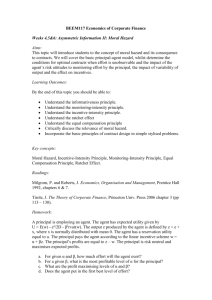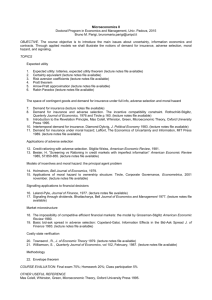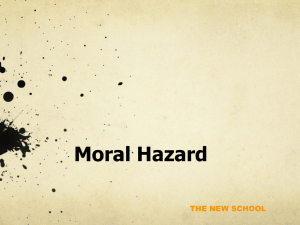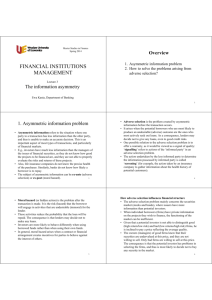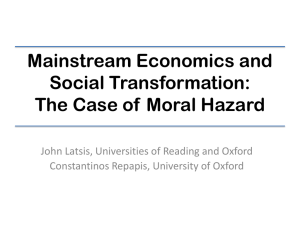The Problems of Adverse Selection and Moral Hazard
advertisement
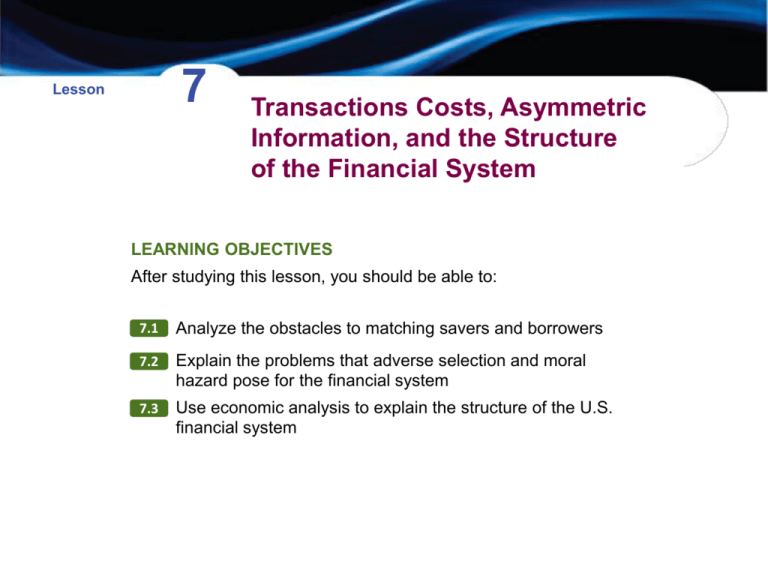
7 Lesson Transactions Costs, Asymmetric Information, and the Structure of the Financial System LEARNING OBJECTIVES After studying this lesson, you should be able to: 7.1 Analyze the obstacles to matching savers and borrowers 7.2 Explain the problems that adverse selection and moral hazard pose for the financial system 7.3 Use economic analysis to explain the structure of the U.S. financial system LESSON 7 Transactions Costs, Asymmetric Information, and the Structure of the Financial System BUYER BEWARE IN FINANCIAL MARKETS! •The fraud case filed by the SEC against Goldman Sachs in 2010 highlights the important problem of asymmetric information. •In this case, asymmetric information means that Goldman Sachs, as the seller of the Abacus collateralized debt obligations (CDOs), clearly had more information than did the buyers. . Key Issue and Question Here are the key issue and key question for this lesson: Issue: During the 2007–2007 financial crisis, many economists noted that problems in the market for bonds had the potential to deepen the economic recession and slow the recovery because firms rely more heavily on bonds than on stocks as a source of external finance. Question: Why do firms rely more on bonds than on stocks as a source of external finance? 7.1 Learning Objective Analyze the obstacles to matching savers and borrowers. The Problems Facing Small Investors Transactions costs The cost of a trade or exchange; for example, the brokerage commission charged for buying or selling a financial asset. Information costs The costs that savers incur to determine the creditworthiness of borrowers and to monitor how they use the funds acquired. Obstacles to Matching Savers and Borrowers How Financial Intermediaries Reduce Transactions Costs • Small investors and small- to medium-sized firms turn to financial intermediaries to meet their financial needs. • Transaction costs can be reduced by taking advantage of economies of scale. Economies of scale The reduction in average cost that results from an increase in the volume of a good or service produced. Obstacles to Matching Savers and Borrowers 7.2 Learning Objective Explain the problems that adverse selection and moral hazard pose for the financial system. Asymmetric information The situation in which one party to an economic transaction has better information than does the other party. Economists distinguish between two problems arising from asymmetric information: Adverse selection The problem investors experience in distinguishing low-risk borrowers from high-risk borrowers before making an investment; in insurance, the problem that those most likely to buy insurance are also most likely to file claims. Moral hazard The risk that people will take actions after they have entered into a transaction that will make the other party worse off; in financial markets, the problem investors experience in verifying that borrowers are using their funds as intended. The Problems of Adverse Selection and Moral Hazard Adverse Selection • The seller of a used car has more information on the true condition of a car than does a potential buyer. • The prices that potential buyers are willing to pay reflect the buyers’ lack of complete information on the true condition of the car. •Because of asymmetric information, the used car market adversely selects the cars that will be offered for sale. The Problems of Adverse Selection and Moral Hazard “Lemons Problems” in Financial Markets • Consider a stock market example. If 70% of the firms in the market are good firms and 10% are lemons, and the good firm’s share of stock is $50, then: • So, you would be willing to pay $45.50 for a share of stock, but to a good firm this is below the fundamental value of the stock. The Problems of Adverse Selection and Moral Hazard “Lemons Problems” in Financial Markets • Adverse selection is present in the bond market as well. • As interest rates on bonds rise, a larger fraction of the firms willing to pay the high interest rates are lemon firms. Credit rationing The restriction of credit by lenders such that borrowers cannot obtain the funds they desire at the given interest rate. • When lenders ration credit, firms—whether they are good firms or lemons—may have difficulty borrowing funds. The Problems of Adverse Selection and Moral Hazard Attempts to Reduce Adverse Selection • Disclosure of information to the SEC reduces the information costs of adverse selection, but it doesn’t eliminate them for three reasons: • Some good firms may be too young to have much information for potential investors to evaluate. • Lemon firms will try to present the information in the best possible light so that investors will overvalue their securities. • There can be legitimate differences of opinion about how to report some items on income statements and balance sheets. The Problems of Adverse Selection and Moral Hazard Attempts to Reduce Adverse Selection • Private firms have collected and sold information about firms to investors to reduce adverse selection costs. • Information is collected from sources such as firms’ income statements, balance sheets, and investment decisions. • Individuals who gain access to the information without paying for it are free riders. The Problems of Adverse Selection and Moral Hazard The Use of Collateral and Net Worth to Reduce Adverse Selection Problems Collateral Assets that a borrower pledges to a lender that the lender may seize if the borrower defaults on the loan. Net worth The difference between the value of a firm’s assets and the value of its liabilities. The Problems of Adverse Selection and Moral Hazard How Financial Intermediaries Reduce Adverse Selection Problems Relationship banking The ability of banks to assess credit risks on the basis of private information about borrowers. The information advantage banks gain from relationship banking allows them to reduce the costs of adverse selection and explains the key role banks play in providing external financing to firms. The Problems of Adverse Selection and Moral Hazard Making the Connection Has Securitization Increased Adverse Selection Problems in the Financial System? • In the episode involving Goldman Sachs’s Abacus CDOs, one of the buyers, IKB, expected Abacus to be a good CDO. According to the SEC, however, it was designed to be a lemon. • The Abacus CDO resulted from the process of securitization, which involves bundling loans, such as mortgages, into securities that can be sold in financial markets. • The increase in securitization may have led to an increase in adverse selection. Securitization and the originate-to-distribute business model may reduce banks’ incentive to distinguish between good borrowers and lemon borrowers. The Problems of Adverse Selection and Moral Hazard Solved Problem 7.2 Why Do Banks Ration Credit? During the spring of 2010, an article in the Economist magazine claimed that small businesses are not getting access to credit. a. Why would banks be unwilling to make loans to small businesses? If the banks believe some of the loans are risky, why wouldn’t they just charge a higher interest rate to compensate for the risk? b. Does it matter that the period involved here was shortly after the end of a deep recession? The Problems of Adverse Selection and Moral Hazard Solved Problem 7.2 Why Do Banks Ration Credit? Solving the Problem Step 1 Review the lesson material. Step 2 Answer part (a) by explaining how raising interest rates on loans can increase adverse selection problems for banks. High interest rates may attract less creditworthy borrowers. A small business that is close to declaring bankruptcy may be less concerned about having to pay a high interest rate than would a borrower in better financial health. Step 3 Answer part (b) by discussing whether it mattered that the period involved was near the end of a deep recession. During a recession, the financial health of households and firms will deteriorate, and the number of lemon borrowers rises relative to the number of good borrowers. So many banks engaged in credit rationing by limiting the number of loans they offered rather than increasing interest rates. The Problems of Adverse Selection and Moral Hazard Moral Hazard • Moral hazard arises because of asymmetric information: The borrower knows more than the lender does about how the borrowed funds will actually be used. Moral Hazard in the Stock Market • The organization of large, publicly traded corporations results in a separation of ownership from control. Principal–agent problem The moral hazard problem of managers (the agents) pursuing their own interests rather than those of shareholders (the principals). The Problems of Adverse Selection and Moral Hazard Moral Hazard in the Stock Market • Managers have an incentive to underreport profits so that they can reduce dividends and retain the use of the funds. • To reduce this problem, the SEC requires managers to issue financial statements. • Boards of directors meet infrequently and may not be independent of top managers. • Some boards of directors use incentive contracts to align the goals of managers with the goals of shareholders. • Compensation tied to the firm’s profits, however, may lead managers to undertake risky investments. The Problems of Adverse Selection and Moral Hazard Moral Hazard in the Bond Market • There is less moral hazard in the bond market than in the stock market. • To reduce moral hazard in bond markets, investors insert restrictive covenants into bond contracts. Restrictive covenant A clause in a bond contract that places limits on the uses of funds that a borrower receives. The Problems of Adverse Selection and Moral Hazard How Financial Intermediaries Reduce Moral Hazard Problems • Financial intermediaries have evolved to fill the gap left by the ban on banks making equity investments in nonfinancial firms. Venture capital firm A firm that raises equity capital from investors to invest in start-up firms. Private equity firm (or corporate restructuring firm) A firm that raises equity capital to acquire shares in other firms to reduce free-rider and moral hazard problems. • A market for corporate control provides a means to remove top management that is failing to carry out the wishes of shareholders. The Problems of Adverse Selection and Moral Hazard Making the Connection Why So Many Ponzi Schemes? • Ponzi schemes derive their name from Charles Ponzi, an Italian immigrant who lived in Boston in the 1720s. • Ponzi schemes are an extreme form of moral hazard. • During the financial crisis of 2007–2007, the most spectacular one was a Ponzi scheme run by Bernard Madoff. • Investors were lured by Madoff because, not only were many legitimate investments earning high returns, but the ever increasing complexity of financial securities made the claims of Ponzi schemes seem more plausible. The Problems of Adverse Selection and Moral Hazard 7.3 Learning Objective Use economic analysis to explain the structure of the U.S. financial system. Figure 7.1 Sources of External Funds to Small- to Medium-Sized Firms Small- and mediumsized businesses rely on loans—particularly mortgages—and trade credit as their major sources of external finance. Conclusions about the Structure of the U.S. Financial System Figure 7.2 External Sources of Funds to Corporations Conclusions about the Structure of the U.S. Financial System Three key features of the financial system: 1. Loans from financial intermediaries are the most important external source of funds for small- to medium-sized firms. Smaller firms cannot borrow directly from savers because transactions costs are too high; they cannot sell bonds or stocks because of the adverse selection and moral hazard problems that arise from asymmetric information. Conclusions about the Structure of the U.S. Financial System Three key features of the financial system: 2. The stock market is a less important source of external funds to corporations than is the bond market. • Most of the trading on the stock market involves existing shares, not new shares of stock. • In recent years, corporations have actually bought back from investors more stock than they have issued. • Moral hazard is less of a problem with debt contracts than with equity contracts. Conclusions about the Structure of the U.S. Financial System Three key features of the financial system: 3. Debt contracts usually require collateral or restrictive covenants. • Large household loans use the good being purchased as collateral. • Many corporate bonds also specify collateral. • To reduce moral hazard, both loans and bonds typically contain restrictive covenants. Conclusions about the Structure of the U.S. Financial System • By reducing transactions and information costs, financial intermediaries can offer savers higher interest rates, offer borrowers lower interest rates, and still earn a profit. • Commercial banks, investment banks, and other financial firms are continually searching for ways to earn a profit by expediting the flow of funds from savers to borrowers. Some of these ways involve developing new financial securities. Conclusions about the Structure of the U.S. Financial System Making the Connection What Was the Problem with the Abacus CDOs? • According to the civil fraud complaint the SEC filed against Goldman Sachs, potential purchasers of the CDO would be unknowingly buying a security that had been constructed to fail. • The SEC argued that Goldman Sachs had an obligation to inform the other potential investors that Paulson & Co. intended to buy CDS contracts on the CDOs after they were issued. • Goldman argued that it was not actually selling the CDOs but was instead acting as a market maker in them. • Because the information costs of these securities are very high, they lack transparency. Goldman Sachs, in testimony before Congress, agreed that it would be appropriate for the SEC to monitor the sale of complex securities, such as the Abacus CDOs, more closely. Conclusions about the Structure of the U.S. Financial System Answering the Key Question At the beginning of this lesson, we asked the question: “Why do firms rely more on bonds than on stocks as a source of external finance?” We have seen that both the bond market and the stock market are subject to problems of moral hazard. In both cases, investors have to be concerned that firms will not use received investment funds for their intended purpose. The problem of moral hazard is considerably less serious, though, when an investor buys a firm’s bonds than when the investor buys a firm’s stock. As a result, investors are more willing to buy bonds than stock, which explains why bonds are a more important source of external finance for firms. AN INSIDE LOOK AT POLICY Ratings Downgrades Happen Too Late for Investors in Mortgage-Backed Securities WALL STREET JOURNAL, Abacus Deal: As Bad As They Come Key Points in the Article • Less than one year after the deal was completed, all the bonds that were selected for Abacus 2007-AC1 were downgraded. • Ratings agencies contributed to the financial crisis by placing their highest ratings on the Abacus deal and others like it. • The firm, Paulson & Co., specifically chose mortgage bonds that were likely to go bad, and it bet against the deal. • Those who bought Abacus 2007-AC1 and other CDOs were the victims of this asymmetric information. • The complexity of the deals made it difficult even for highly knowledgeable investors to evaluate their worth. AN INSIDE LOOK AT POLICY In February 2008, ratings agencies downgraded nearly all the assets (including the 70 mortgage bonds in Abacus 2007-AC1) that were packaged to form five CDOs.
